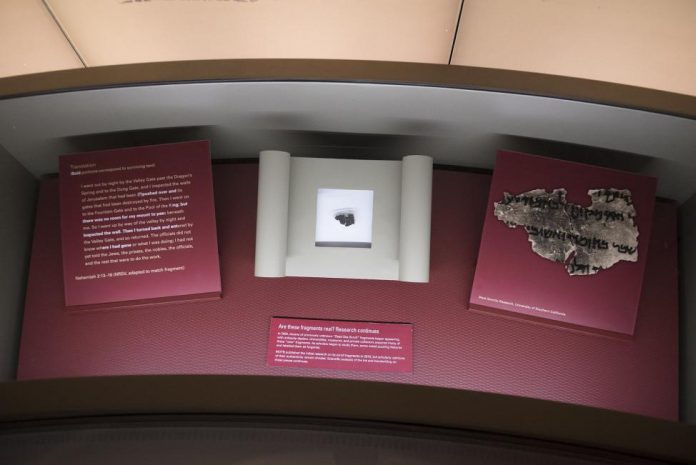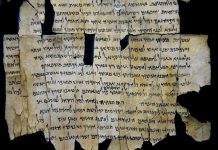
March 14 (UPI) — An art fraud investigation team announced Friday that none of the Museum of the Bible’s Dead Sea Scrolls fragments is genuine.
The results of the third-party scientific analysis by Art Fraud Insights came more than a year after the museum determined that five of its fragments were fake and removed them from exhibition.
“After an exhaustive review of all the imaging and scientific analysis results, it is evident that none of the textual fragments in Museum of the Bible’s Dead Sea Scroll collection are authentic,” said Colette Loll, founder and director of Art Fraud Insights. “Moreover, each exhibits characteristics that suggest they are deliberate forgeries created in the 20th century with the intent to mimic authentic Dead Sea Scroll fragments.”
Museum officials said they planned to continue using the services of Art Fraud Insights to analyze the facility’s entire collection.
“Notwithstanding the less than favorable results, we have done what no other institution with post-2002 DSS fragments has done,” Museum of the Bible Chief Curatorial Officer Jeffrey Kloha said. “The sophisticated and costly methods employed to discover the truth about our collection could be used to shed light on other suspicious fragments and perhaps even be effective in uncovering who is responsible for these forgeries.”
Before it opened in November 2017, the Museum of the Bible’s collection came under scrutiny by critics of the collecting practices of Hobby Lobby President Steve Green, who donated some of the exhibits at the museum. He donated the five fragments discredited in 2018.
The Green family has collected about 40,000 artifacts worth more than $205 million over the past decade.
In May 2018, Hobby Lobby returned thousands of historic artifacts from modern-day Iraq that Green purchased in Dubai and improperly brought to the United States. He paid $1.6 million for 5,500 pieces, which included 4,000-year-old cuneiform tablets and stone cylinders, in 2010. The company also agreed to pay a $3 million fine.
The Department of Justice found that the company had the tablets shipped to its Oklahoma headquarters, but that the boxes were labeled as containing ceramic tile samples. Green promised more oversight at the time and blamed the incident on his own inexperience as a collector.
“We made mistakes, but we’ve learned from them,” he said.
“Before this, we weren’t collectors or museum-goers,” Green added. “We didn’t know we needed to ask for all this paperwork” to prove provenance.
Proving prior ownership of an artwork or artifact is meant not only to verify the authenticity of the piece, but to prevent the sale of looted items.
The misstep cast doubt on the veracity of other objects the Green family owns, including some that are on display at the Museum of the Bible.
Loll praised Museum of the Bible officials for being transparent about the inauthentic items.
“Usually, items that are determined to be fake are quietly removed from display and transferred to the euphemistic ‘study collection.’ Museum of the Bible has opted to be as transparent as possible with its collection of Dead Sea Scrolls — from the interim gallery labels, to the public announcement of the results of the research and the subsequent release of all of the associated research materials. This data can now be used for comparison to other questioned fragments. What a tremendous contribution to the field,” she said.



